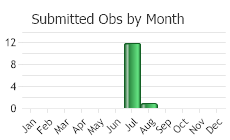View in other NatureServe Network Field Guides
NatureServe
Montana
Utah
Wyoming
Idaho
Wisconsin
British Columbia
South Carolina
Yukon
California
New York
Pale-spiked Lobelia - Lobelia spicata
State Rank Reason (see State Rank above)
Rare and peripheral in Montana, where it is known from a few locations in the northeast corner of the state. Additional data on population levels and trends are needed. Unclear if any of the documented occurrences are subject to negative impacts or disturbances.
General Description
Pale-spiked Lobelia is an herbaceous perennial with unbranched stems that are 2-8 dm high. The oblong, lance-shaped leaves are 5-10 cm long, have toothed margins and short petioles, and become smaller up the stem. Foliage is glabrous to sparsely short-hairy. Flowers are 7-12 mm long and are born on short, 2-5 mm long stalks in a sparingly branched, narrow, crowded inflorescence. Each flower has 5 narrow sepals that are 5-9 mm long and a light blue, tubular, 4-10 mm long corolla that flares into a spreading 2-lobed upper lip and a 3-lobed lower lip. The ovary is below the base of the corolla and matures into a nearly globose capsule that is 3-5 mm high.
Lobelia is named for the botanist Mathias de L'Obel (Morley 1970). In 1570, Mathias along with Pierre Pena published the first book that arranged plants by leaf characteristics, which represented a major advancement in the study of plant classification (Morley 1970).
Phenology
Flowering in late July - early August.
Diagnostic Characteristics
Lobelia kalmii is confined to very wet soils. Other species of Campanulaceae with Lobelia-like flowers are annuals and are usually found in wetlands.
Species Range
Montana Range
Range Descriptions

 Native
Native
Range Comments
SK to QC, south to TX, LA, MS and GA (Lesica et al. 2012. Manual of Montana Vascular Plants. BRIT Press. Fort Worth, TX).
Observations in Montana Natural Heritage Program Database
Number of Observations: 24
(Click on the following maps and charts to see full sized version)
Map Help and Descriptions
Relative Density

Recency



 (Observations spanning multiple months or years are excluded from time charts)
(Observations spanning multiple months or years are excluded from time charts)
Habitat
Moist meadows on the plains.
National Vegetation Classification System Groups Associated with this Species
Grassland
Lowland - Prairie Grassland
Wetland and Riparian
Wet Meadow and Marsh
Ecology
POLLINATORS The following animal species have been reported as pollinators of this plant species or its genus where their geographic ranges overlap:
Bombus fervidus,
Bombus pensylvanicus, and
Bombus griseocollis (Colla and Dumesh 2010).
Stewardship Responsibility
Threats or Limiting Factors
STATE THREAT SCORE REASON
Threat impact not assigned because threats are not known (MTNHP Threat Assessment 2021).
References
- Literature Cited AboveLegend:
 View Online Publication
View Online Publication Colla, S.R. and S. Dumesh. 2010. The bumble bees of southern Ontario: notes on natural history and distribution. Journal of the Entomological Society of Ontario 141:39-68.
Colla, S.R. and S. Dumesh. 2010. The bumble bees of southern Ontario: notes on natural history and distribution. Journal of the Entomological Society of Ontario 141:39-68. Lesica, P., M.T. Lavin, and P.F. Stickney. 2012. Manual of Montana Vascular Plants. Fort Worth, TX: BRIT Press. viii + 771 p.
Lesica, P., M.T. Lavin, and P.F. Stickney. 2012. Manual of Montana Vascular Plants. Fort Worth, TX: BRIT Press. viii + 771 p. Morely, Brian D. 1970. Wild Flowers of the World. Paintings by Barbara Everard. First American Edition. Rainbird Reference Books Limited, London, United Kingdom.
Morely, Brian D. 1970. Wild Flowers of the World. Paintings by Barbara Everard. First American Edition. Rainbird Reference Books Limited, London, United Kingdom. MTNHP Threat Assessment. 2021. State Threat Score Assignment and Assessment of Reported Threats from 2006 to 2021 for State-listed Vascular Plants. Botany Program, Montana Natural Heritage Program, Helena, Montana.
MTNHP Threat Assessment. 2021. State Threat Score Assignment and Assessment of Reported Threats from 2006 to 2021 for State-listed Vascular Plants. Botany Program, Montana Natural Heritage Program, Helena, Montana.
- Additional ReferencesLegend:
 View Online Publication
View Online Publication
Do you know of a citation we're missing? Heidel, B.L., S.V. Cooper and C. Jean. 2000. Plant species of special concern and plant associations of Sheridan County, Montana. Report to U.S. Fish and Wildlife Service. Montana Natural Heritage Program, Helena, Montana. 96 p.
Heidel, B.L., S.V. Cooper and C. Jean. 2000. Plant species of special concern and plant associations of Sheridan County, Montana. Report to U.S. Fish and Wildlife Service. Montana Natural Heritage Program, Helena, Montana. 96 p. Lesica, P., M.T. Lavin, and P.F. Stickney. 2022. Manual of Montana Vascular Plants, Second Edition. Fort Worth, TX: BRIT Press. viii + 779 p.
Lesica, P., M.T. Lavin, and P.F. Stickney. 2022. Manual of Montana Vascular Plants, Second Edition. Fort Worth, TX: BRIT Press. viii + 779 p.
- Web Search Engines for Articles on "Pale-spiked Lobelia"





